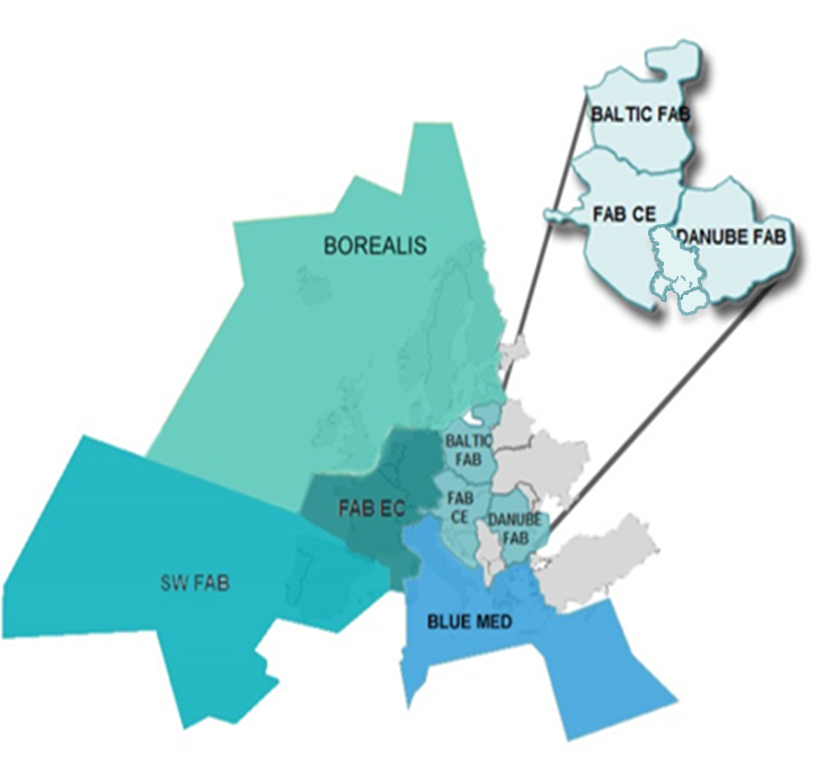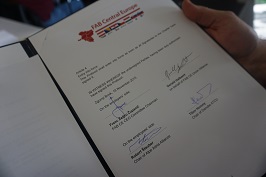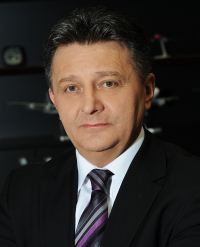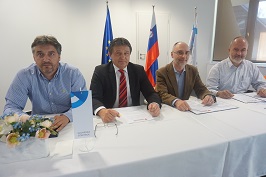FAB CE News
 The members of the GATE One (GO) initiative, which is one of the largest regional ANSP platforms in Europe, agreed to play a more active role to explore potential for future inter-FAB cooperation. The CEOs of the GO Initiative which includes designated ANSPs covering 3 existing FABs (Baltic FAB, Danube FAB and FAB CE) and 2 non-EU FIRs (Belgrade and Skopje) - at their meeting in Sofia on 3rd December agreed to strengthen their operational and technical cooperation.
The members of the GATE One (GO) initiative, which is one of the largest regional ANSP platforms in Europe, agreed to play a more active role to explore potential for future inter-FAB cooperation. The CEOs of the GO Initiative which includes designated ANSPs covering 3 existing FABs (Baltic FAB, Danube FAB and FAB CE) and 2 non-EU FIRs (Belgrade and Skopje) - at their meeting in Sofia on 3rd December agreed to strengthen their operational and technical cooperation.
As a pilot common project the CEOs proposed to launch a study to synchronize cross-border Free Route (FRA) implementation in the region for the airspace serviced by GO members. The participating CEOs went along with the opinion to keep GO as a cooperation platform. „The ANSP members supported the proposed vision, which will allow us to work more closely together among others for airspace optimization, thus to be able to offer the best possible longer term ATM solutions for our airspace users” – said Miroslav Bartos, Chairman of the GO CEO Committee meeting. GO members will continue with their ongoing FAB development and national ATM improvement projects. GO FRA shall be developed on top of the existing ATM efforts being a kind of regional FRA umbrella project. It will be built step by step, making best use of the lessons learnt from similar regional initiatives and to get common benefits from SES/SESAR deployment.
Another significant outcome of the meeting was the accession of SMATSA (the Serbian-Montenegro ANSP) and M-NAV (Macedonian ANSP) to the GO initiative. „We are very pleased to join the GO initiative, thus we can act as a bridge between our region and other initiatives. We look forward to working on airspace defragmentation together with all GO members. Our airspace is an important transit corridor and we need to develop a synchronized FRA Concept of Operation in close cooperation with our neighbouring ANSPs. For us, GATE One is also a „door” which can bring us to a future pan-European Single Sky” – stated the SMATSA and the M-NAV delegation.
Note to editors GATE One (GO) is a bottom up regional ANSP initiative established in 2013. The members of GO are ANS Czech Republic, Austro Control, BHANSA, BULATSA, Croatia Control, HungaroControl, LPS Slovak Republic, M-NAV, ORO NAVIGACIJA, PANSA, Romatsa, Slovenia Control and SMATSA. In 2014 GO members provided air navigation services for 3.4 million of IFR flights in 3 FABs. This is about 35% of the total number of European Air Traffic. The GO average cost of ANS provision remained well below the European Key Performance Area (KPA) cost efficiency target.
Social Dialogue Charter amended - ATCO Mobility Paper Signed
The second FAB CE Social Dialogue Forum was held on November 19 in Ljubljana. Chaired by Franc Željko Županič, CEOC Chairman, and co-chaired by Mr. Željko Oreški (Alpe Adria Alliance), the Forum was attended by over 40 participants, including observers from SMATSA Trade Union. The Forum was conducted in a very positive and constructive manner by all participants.
Two major milestones were achieved at the Social Dialogue Forum in Ljubljana. First the Social Dialogue Charter was amended, paving the way for the FAB CE Alpe Adria Alliance to officially join the Social Dialogue . This represents a significant step in further improving and solidifying the good relationship between ANSPs and unions.
. This represents a significant step in further improving and solidifying the good relationship between ANSPs and unions.
This was followed by the signing of the ATCO Mobility Paper by the CEOC and the ATCO unions. After months of intensive discussions an agreement was finally reached. The paper contains the common position of Air Navigation Services Providers and the ATCO Unions regarding the mobility of ATCOs. Among the principles agreed upon were that ATCO mobility should not be used as a tool to introduce social dumping and that a consultation process should be set up at a national level to avoid conflicts. The positive outcome of this Social Dialogue Forum was a perfect showcase of ANSPs and unions working together to achieve results, which benefit all parties.
Other topics on the agenda included updates on the FAB CE Strategy, the FAB CE Legal Entity, FAB CE Just Culture and the FAB CE Safety Performance Indicators.
ANSP Cooperation Agreement signed by DANUBE FAB and FAB CE aims towards the optimisation of air traffic management (ATM) in the region
An agreement at Air Navigation Services Provider (ANSP) level between DANUBE FAB and FAB Central Europe (FAB CE) was signed on 14 October 2015 by the Co-Chairmen of the DANUBE FAB ANSP Board and the Chairman of the FAB CE CEO Committee, with the aim of establishing and enhancing cooperation in ATM in the two adjacent Functional Airspace Blocks.
The Agreement was signed with the occasion of the Second Inter-FAB Coordination Workshop organised by the DANUBE FAB in Bucharest, where all nine FABs attended with a view to enhance cooperation and share lessons learned.
Through the signature of this Agreement, DANUBE FAB and FAB CE have created a framework for cooperation for nine ANSPs; BULATSA and ROMATSA on the part of DANUBE FAB, and Austro Control, BHANSA, Croatia Control, ANS CR, HungaroControl, LPS SR and Slovenia Control on the part of FAB CE. Establishing a flexible cooperation mechanism, the agreement will contribute towards the safe, efficient and optimised provision of air navigation services.
The Agreement supports the Single European Sky legislation, with the aim of providing a safer, more cost-efficient, environment-friendly and performance-driven service. The areas of cooperation under the Agreement include the areas of operations, technical, training, performance and safety.
DANUBE FAB and FAB CE are committed to continue engaging with neighbouring EU and non-EU States so as to deliver additional benefits and further contribute towards better performance. This signing completes a set of three agreements, between BLUE MED FAB, DANUBE FAB and FAB CE , which collectively form a triangle of cooperation in the region, laying a strong foundation to improve performance throughout South-Eastern and Central Europe.

"The state of play of FAB CE is promising in mid- 2015, with some important milestones accomplished. The RPII Performance Plan with adequate targets submitted to the European Commission, FAB CE legal entity functioning, reorganisation of projects ongoing, trustful relations among partners… Regardless of those facts, as the new CEO Committee Chairman, I am aware, there is still a lot to be done.
The continuation and further development of safe and efficient provision of ATM services in the FAB CE region is of paramount importance, and, with ongoing disturbances in traffic flows in Europe, proper steps in this regard are even more necessary. On the service provision side we will strive to bring the needed capacity while meeting the targets promised in the performance plan. On the project and planning side, the focus will be on the OPS (operations) and TEC (technology) domains, where the FAB CE Free Route Airspace initiative with the needed CONOPS and ATM system requirements will be our main concern in the coming twelve months".
FAB CE Summer Newsletter July 2015 (pdf)
In this Issue:
- - Achievements of the last 12 months
- - FAB CE establishes Common Entity
- - Incoming FAB CE Chair sets agenda
- - EC to monitor FAB CE progress
- - New FCE Director’s viewpoint
- - Social partners exchange ideas
- - Free Route Airspace implementation
- - Responding to regional crises
Chairmanship of the CEO Committee goes to Slovenia
In accordance with the FAB CE ANSP Cooperation Agreement signed in May 2011, Franc Željko Županič, Chief Executive Officer of Slovenia Control has taken over the chairmanship of the CEO Committee from Kornél Szepessy, CEO of HungaroControl. The term will run for one year until June 2016.
One of the major milestones in the past twelve months in respect of FAB CE operations was the founding of the joint venture company “FAB CE Aviation Services Ltd.”. Following several years of preparation, the founding document was signed by representatives of the FAB CE countries that are members of the European Union in October 2014. The purpose of the company established for joint procurement is to support the progress of the FAB CE Programme, and thus the implementation of the European Union’s Single European Sky programme. Currently, the main goal of the cooperation is to establish a joint project management.
An InterFAB agreement was signed by the member states of FAB CE and BLUE MED FAB (Cyprus, Greece, Italy and Malta). The cooperation set the objectives to implement safer, more cost-efficient, more performance-oriented and more sustainable air navigation, and to establish several similar collaborations in the future. The first InterFab coordination workshop was held in Amsterdam in November 2014. The representatives of nine European functional airspace blocks shared their experiences on implementation of FABs and discussed the planned introduction of the Free Route concept in Europe.
Considerable progress was made in reviving the FAB CE Social Dialogue. The completion of the Social Dialogue Charter that serves as a basis for the dialogue between the unions and ANSPs, considerably moved forward.
Page 29 of 40

